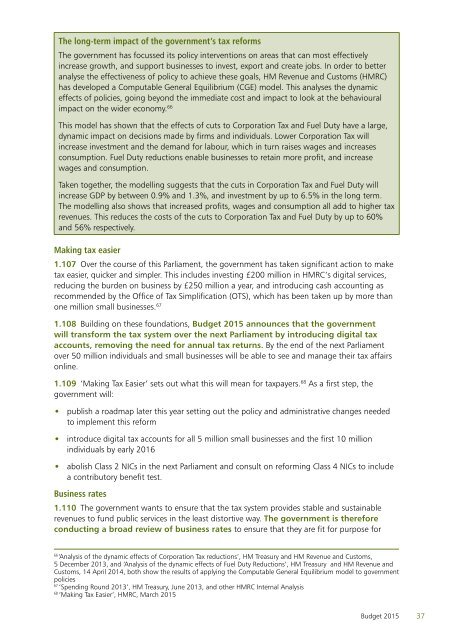Create successful ePaper yourself
Turn your PDF publications into a flip-book with our unique Google optimized e-Paper software.
The long-term impact of the government’s tax reformsThe government has focussed its policy interventions on areas that can most effectivelyincrease growth, and support businesses to invest, export and create jobs. In order to betteranalyse the effectiveness of policy to achieve these goals, HM Revenue and Customs (HMRC)has developed a Computable General Equilibrium (CGE) model. This analyses the dynamiceffects of policies, going beyond the immediate cost and impact to look at the behaviouralimpact on the wider economy. 66This model has shown that the effects of cuts to Corporation Tax and Fuel Duty have a large,dynamic impact on decisions made by firms and individuals. Lower Corporation Tax willincrease investment and the demand for labour, which in turn raises wages and increasesconsumption. Fuel Duty reductions enable businesses to retain more profit, and increasewages and consumption.Taken together, the modelling suggests that the cuts in Corporation Tax and Fuel Duty willincrease GDP by between 0.9% and 1.3%, and investment by up to 6.5% in the long term.The modelling also shows that increased profits, wages and consumption all add to higher taxrevenues. This reduces the costs of the cuts to Corporation Tax and Fuel Duty by up to 60%and 56% respectively.Making tax easier1.107 Over the course of this Parliament, the government has taken significant action to maketax easier, quicker and simpler. This includes investing £200 million in HMRC’s digital services,reducing the burden on business by £250 million a year, and introducing cash accounting asrecommended by the Office of Tax Simplification (OTS), which has been taken up by more thanone million small businesses. 671.108 Building on these foundations, <strong>Budget</strong> <strong>2015</strong> announces that the governmentwill transform the tax system over the next Parliament by introducing digital taxaccounts, removing the need for annual tax returns. By the end of the next Parliamentover 50 million individuals and small businesses will be able to see and manage their tax affairsonline.1.109 ‘Making Tax Easier’ sets out what this will mean for taxpayers. 68 As a first step, thegovernment will:••publish a roadmap later this year setting out the policy and administrative changes neededto implement this reform••introduce digital tax accounts for all 5 million small businesses and the first 10 millionindividuals by early 2016••abolish Class 2 NICs in the next Parliament and consult on reforming Class 4 NICs to includea contributory benefit test.Business rates1.110 The government wants to ensure that the tax system provides stable and sustainablerevenues to fund public services in the least distortive way. The government is thereforeconducting a broad review of business rates to ensure that they are fit for purpose for66‘Analysis of the dynamic effects of Corporation Tax reductions’, HM Treasury and HM Revenue and Customs,5 December 2013, and ‘Analysis of the dynamic effects of Fuel Duty Reductions’, HM Treasury and HM Revenue andCustoms, 14 April 2014, both show the results of applying the Computable General Equilibrium model to governmentpolicies67‘Spending Round 2013’, HM Treasury, June 2013, and other HMRC Internal Analysis68‘Making Tax Easier’, HMRC, March <strong>2015</strong><strong>Budget</strong> <strong>2015</strong>37


